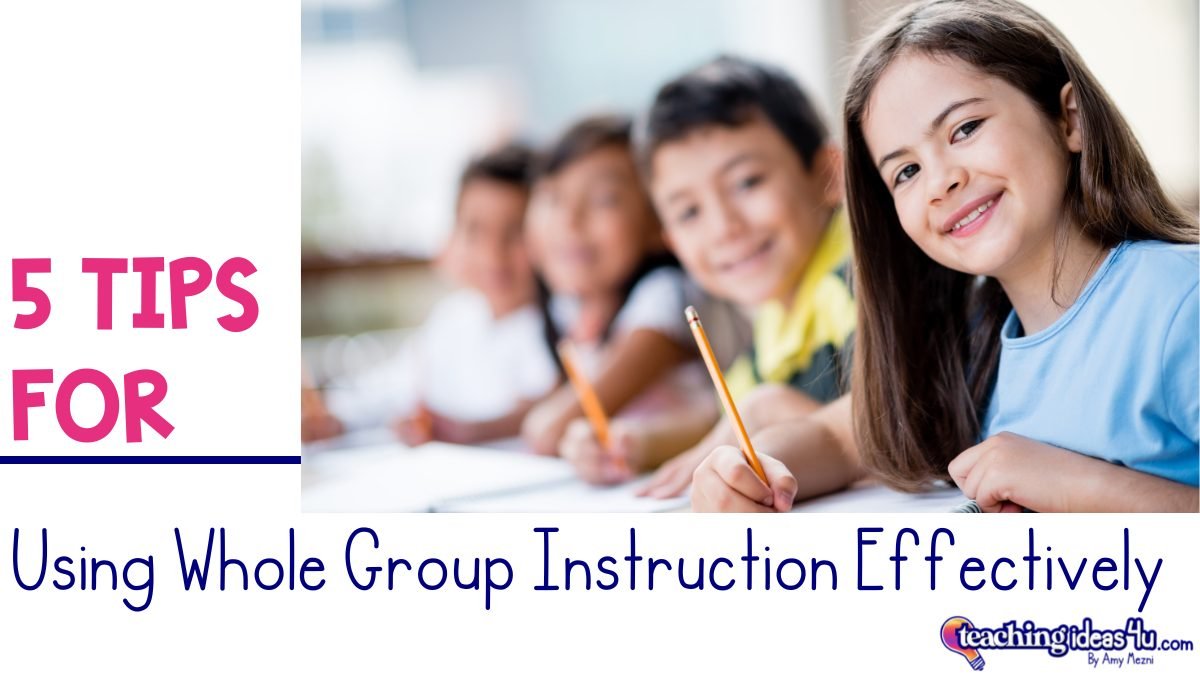5 Tips For Using Whole Group Instruction Effectively
1. Use Formative & Summative Assessments
You need to know what students know and don’t know. Basing your whole-group instruction off student data will be the most effective use of your class time. If students have already mastered multiplication, then you can move on to the next concept. Likewise, if students don’t understand, you can reteach. It is easy to assume students understand the lessons based on class discussions, but it is wise to get hard data to make sure. One time, I made the mistake of thinking the students really understood the social studies concepts from reading and discussing them. I had an unpleasant surprise when most students failed the assessment.
2. Keep It Short
Students have an attention span that is roughly equal to their age, so a ten-year-old has a roughly ten-minute attention span. Whole group instruction needs to mix things up quickly in order to keep everyone focused. This doesn’t necessarily mean that you are constantly switching lessons. Instead, build in activities throughout the lesson that mix up what students are doing.
3. Whole Group = Active Learning
Students should not be passively listening to a lecture for an entire class. Students need to be actively working on mastering a skill or concept.
While you might begin whole-group instruction with a short teacher-led lecture, the rest of the period should involve the students working on the concept being taught.
Here is an example of how you might break up a lesson:
10 min - Teacher-led direct instruction of a concept
5 min - Students turn and talk about the concept with their shoulder partners, then volunteers summarize their conversation for the class.
5 - 10 min - Class practices concept together.
5 - 10 min - Students practice the concept with a small group or a partner. (Table group, shoulder partner, etc.)
5 - 10 min - Students practice or write about the concept on their own.
By constantly breaking into activities, the regrouping for whole group discussion and instruction, you keep the students on task because they are frequently refocused on a new activity.
4. Less Is More
Students need a lot of practice to master a concept. Think about your teacher-led instruction. Are you trying to cover multiple concepts at once? Do you focus on one core skill or are you covering multiple skills? If you are trying to teach multiple skills in one lesson, you will have more success by breaking it into multiple lessons that each focus on just one part. For example, writing can be hard for teachers to explain. Sometimes, we try to explain to students how to plan the entire essay at once, which tends to fail miserably. Students who are strong writers catch on, and everyone else is confused. If you teach selecting a topic in one lesson, then how to find the support for their topic in another, making an outline in the next class, etc, students will have time to master each step before being overwhelmed with multiple new skills. Focus each lesson on one core skill or concept, and use class time to circulate and check on students’ understanding as they discuss and practice it.
5. Use the Right Teaching Method
One tool cannot do everything. You wouldn’t use a hammer when you need a screwdriver, and you shouldn’t use whole-group instruction if small-group instruction would be best. There will be times when you need whole-group instruction and others when you need small-group instruction. One isn’t necessarily better than the other, but they meet different needs. Whole-group instruction might be better when you are introducing a new concept and want to circulate as students discuss and practice it. Small-group instruction might be better if most of the class has mastered a concept, but a handful of students need more support. Use your knowledge of your students to plan your lessons in a way that best meets everyone’s learning needs.
Teaching Reading Strategies
It is possible to teach a new skill to the entire class but still differentiate. For example, these Reading Strategy units were created to be used with any book. You can use one to teach the concept, whether it’s the main idea, inference, or synthesizing, to the whole class, but then students can practice the concept with a text on their reading level.
Each unit includes notes, journal entries, multiple practice pieces, and assessments. The eight units are available for both print and digital.

